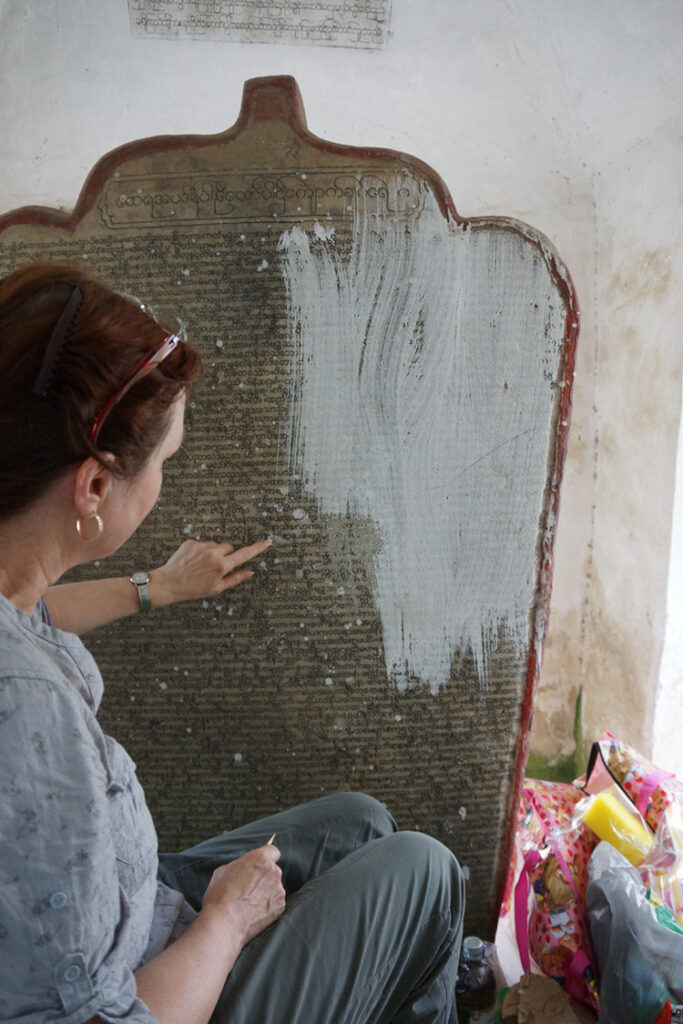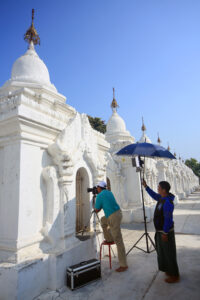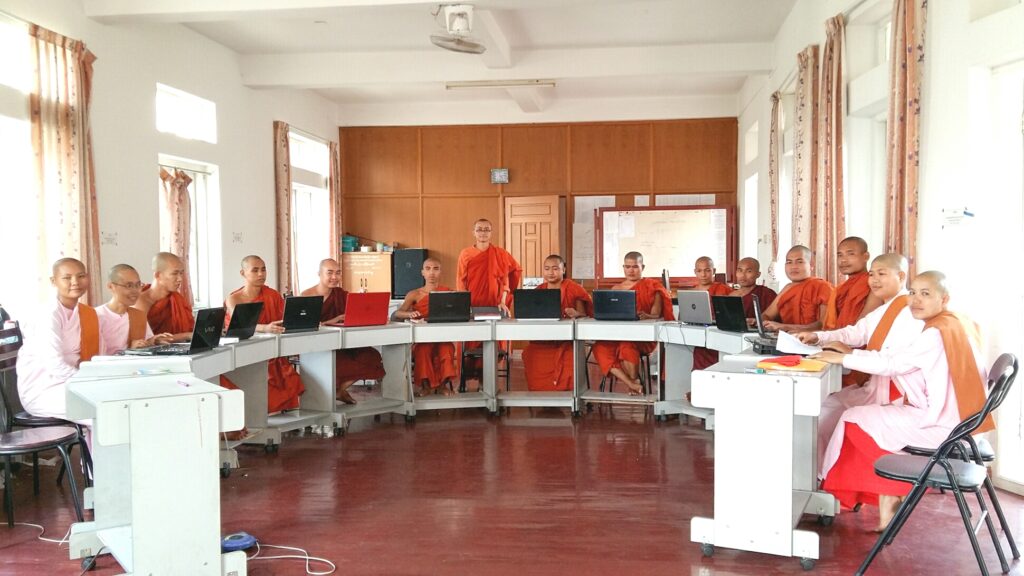Kuthodaw Pagoda
Prior research on the Kuthodaw Pagoda site
While a few publications in the late nineteenth and early twentieth centuries briefly discussed the Kuthodaw Pagoda, the first to seriously research this topic was Willem Bollée (1968) of the University of Heidelberg, who photographed a number of the stelae and compared its recension with other versions. Alpha Computer in Mandalay released a CD-ROM in 2006 with digital photographs of all 729 stelae. Unfortunately, these photographs have a poor resolution and are mostly unreadable. The late Primoz Pecenko, a Pali scholar based at the University of Queensland, Australia, initiated a research project on the Kuthodaw Pagoda, which included a comparison of the Kuthodaw Pagoda recension of the Dhammapada with the Sixth Council edition. His unexpected passing away in 2007, however, brought the project to an end in its early stages.
Aims of the Kuthodaw Pagoda Project
Inspired by Pecenko’s research, in late 2012 a group of scholars at the University of Sydney and Nan Tien Institute, Wollongong, established a collaborative research project with the following aims:
- To clean the inscriptions and to produce a long-term strategy for their restoration and conservation
- To digitally photograph all the inscriptions carved on the marble stelae
- To produce and make freely available a database of the high-resolution images of all the inscriptions
- To create an electronic edition of the Kuthodaw Pagoda text
Team members and collaborators
Australian team members:
- Dr Mark Allon (Chair, Department of Indian Subcontinental Studies, University of Sydney)
- Dr Tamara Ditrich (Professor [Research], Department of Asian Studies, University of Ljubljana, Slovenia, and Honorary Associate, University of Sydney)
- Dr Chris Clark (Honorary Associate, University of Sydney)
- Dr Royce Wiles (independent scholar)
- Dr Wendy Reade (consultant conservator; Principal Conservator, Objects and Outdoor Heritage, International Conservation Services, Sydney; Honorary Associate, University of Sydney)
- Dr Ian McCrabb (project consultant; Prakaś Foundation)
- Dr Bob Hudson (consultant archaeologist; Honorary Associate, Department of Archaeology, University of Sydney)
Myanmar collaborators:
- Department of Archaeology, Mandalay: Directors, Assistant Directors, conservators and general staff members
- Mandalay conservation project manager: U Wai Lwin, retired staff member of the Department of Archaeology, Mandalay
- The Sitagu International Buddhist Academy, including Mandalay transcription project manager Dr Venerable Dhammācāra
- Kuthodaw Pagoda Trustee Committee
- Photographers U Kyaw Thu Win and team of Hla Gon Yee, Mandalay
Conservation of the Kuthodaw Pagoda site
In 2013 our team made a field trip to Myanmar to conduct a preliminary assessment of the Kuthodaw Pagoda site. During this assessment, we discovered that parts of the site were in a state of disrepair and the stelae text had become obscured by decades of dirt, whitewash, graffiti, insect nests and animal droppings. It was concluded that conservation work was urgently needed to reverse the site’s years of neglect.

In 2014 we were awarded a three-year grant from the Chuo Academic Research Institute of Rissho Kosei-kai, Japan, which provided the funds necessary for us to undertake this work.

In late 2014, a more comprehensive conservation assessment was led by conservator Dr Wendy Reade. The main threats to the preservation of the site were identified as vegetation overgrowth, rising damp, black mould, bat faeces and urine, graffiti and whitewash.
Cleaning strategies for the removal of graffiti, whitewash, bat urine and dirt from the marble stelae were also trialled during this visit, with the goal of identifying methods that were minimally interventive, involving locally available materials, practical on a large site, and which could be carried out using local workers.

During 2015, the Myanmar Ministry of Culture approved our conservation report recommendations, and we began the arduous task of cleaning all stelae, while at the same time training staff at the Department of Archaeology, Mandalay, on cleaning methodology.
Finally, a maintenance plan was devised to provide guidelines for the ongoing preservation of the site in order to keep it at the level of conservation achieved by the project.
We recommended all mini-pagodas be locked to prevent future human impact, particularly graffiti, with the exception of two mini-pagodas near the entrance, which visitors are able to access under the watchful supervision of the Kuthodaw Pagoda trustees who manage the site. This plan included a program of regular tree-trimming, weeding, rubbish removal, drain cleaning, washing the stones to remove bat excretions, covering the stelae during whitewashing, etc.
Photographing of the stelae

After extensive testing of a diversity of imaging techniques in 2014, it was deemed that daytime DSLR photography produced the best quality images while also being the most practical and cost effective method. In 2015, our project employed local professional photographer U Kyaw Win and his company Hla Gon Yee, Mandalay, to photograph all 729 stelae containing the canonical texts and the additional four stelae in the Burmese language. These images have since been mounted on Open Context, an open access resource for the electronic publication of primary field research in archaeology and related disciplines, which archives data with the California Digital Library of the University of California. Each image of the stelae inscriptions has been paired with associated metadata, including stela number, stela side (recto or verso), image framing (upper stela, lower stela, whole stela), subdivision of the Pali canon, stela heading title, and Burmese date on which the inscription was completed and its corresponding Western date.
Transcription project
Prior to our project photographing the Kuthodaw Pagoda marble stelae, the only way to read the Pali canon recension at this site was to visit Mandalay in person. For international scholars, this required considerable time, effort and money. Our creation of an image database of all 733 marble stelae has made this recension much more accessible; however, readers still need to have learnt Burmese script and may struggle to locate specific textual passages because the text in the digital photographs is not searchable. To address these issues, in 2016 we partnered with Sitagu International Buddhist Academy, Mandalay, to create a Roman script transliteration of the Kuthodaw Pagoda recension. The Academy is a monastic university specialising in Buddhist studies and the Mandalay branch is located near the Kuthodaw Pagoda, making it the ideal organisation to undertake this transliteration work. Teams of scholastic monks and nuns at the Academy are steadily working through the stelae inscriptions and have already produced a sizable body of transliterated text. Once completed, this Roman script transliteration of the Kuthodaw Pagoda recension, which represents the Fifth Buddhist Council text, will be freely available to all and will enable fruitful comparisons with, e.g. the transliterated Sixth Buddhist Council text.

Future research
The research our collaborative project has completed to date has laid the foundation for a more thorough investigation of the history of the Kuthodaw Pagoda site and its many inscriptions. This investigation will tell us a great deal about the history of Buddhism in Myanmar and, due to its influence beyond Myanmar, will significantly add to our understanding of transnational Buddhism in Southeast Asia and Sri Lanka, which is still in its infancy. The aims of this future research project are to:
- Determine the nature and status of the recension of the Pali canon preserved at the Kuthodaw Pagoda site.
- Better understand the transmission of Pali literature in Asia by analysing the sources and influence of the Kuthodaw Pagoda recension.
- Produce an accurate and detailed account of the history of the Kuthodaw Pagoda site within the broader context of the history of Buddhism in Southeast Asia and Sri Lanka, including the reasons for King Mindon producing the site and the role played by the invasion of southern Myanmar by the British in 1852.
- Undertake a comprehensive study of the donor inscriptions at the site in order to understand donor patterns and how the site has been used to the present day.
- Develop a digital platform in which high-resolution images of the inscriptions and Roman script transliterations produced by the project are dynamically linked and made freely available online; and to mount donor inscription images, texts and other historical materials on this platform.

